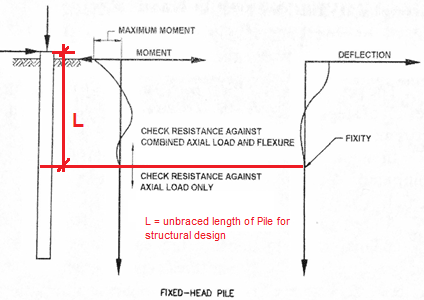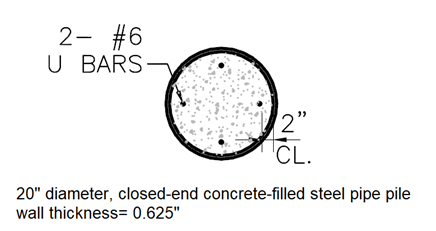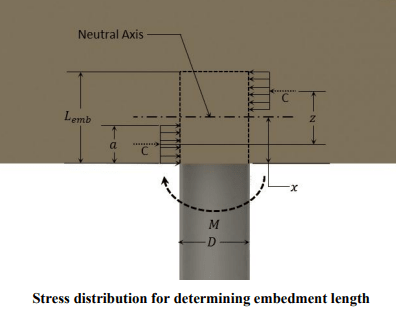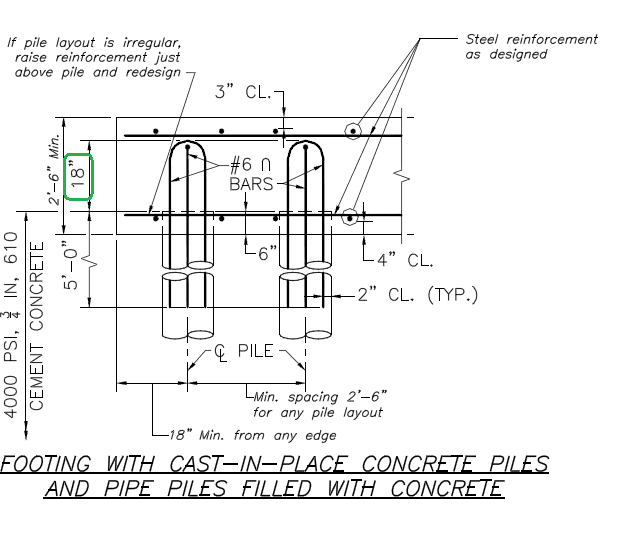AK4S
Structural
- Jan 2, 2015
- 98
I am working on the Structural Design of a Concrete-filled steel pipe pile (Non-composite)and was looking for some clarifications.
Sorry about the long post. I couldnt find a reference which goes through the analysis and so wanted to list it here to confirm my understanding.
SDC-A seismic design category. Non-seismic Load combination controls.
1.The calcs from the Geotech provided the analysis results of lateral response of the pile due to loads at the Top of the Pile.
Fixed-Head condition considered at the Top.
Relevant Outputs: Max. Moment and Location of Pile Fixity from the deflection curve.(used as unbraced length for structural analysis)

Initial Pile cross-section recommended by Geotech:

2. The concrete does little for Flexure as it is unreinforced (minimal rebar) and trying to get composite action to the pipe interior isn’t reliable due to the smooth inner wall of the pipe. Hence a non-composite condition is assumed for analysis.
3.Went through the below steps for design:

Query:
[ol A]
[li]Am I missing anything in the steps above? How should I factor in the concrete to help with Axial/compressive load? Currently I have assumed only the area of the Steel Pipe Section for design (Ags). My interpretation that since the section is non-composite, I should conservatively only consider the strength of the steel pipe and not the concrete since they will compress differently under load.[/li]
[li]Is there a guideline regarding reduction in the thickness of the steel pipe to be considered in design to account for potential corrosion in future? A coal-tar epoxy coating is already proposed for few feet at the top of the pile as a protective measure. The pile is installed in marine environment.[/li]
[li]How do I design/check the pile embedment into the Pile cap? Geotech recommendation was 2ft embedment to achieve fixed head conditions. Pile cap is 4ft thick. I found a reference which went through the analysis by calculating the compression resultant from the stress block for the Moment and checking this compressive stress against design strength(bearing on concrete). See below sketch. Does this look reasonable?[/li]
[/ol]

D.For a non-composite section, is there a guideline for the reinf. required in concrete. 1% min.?
E. Is there special rebar arrangement required around the Pile embedment? I have designed the pile cap for the required flexural reinf. and shear stirrups.
Are Additional circular stirrups around pile section, if so what is the design basis?Per below detail from State Bridge manual, the rebar from pile should project 18" into the pile cap.

Sorry about the long post. I couldnt find a reference which goes through the analysis and so wanted to list it here to confirm my understanding.
SDC-A seismic design category. Non-seismic Load combination controls.
1.The calcs from the Geotech provided the analysis results of lateral response of the pile due to loads at the Top of the Pile.
Fixed-Head condition considered at the Top.
Relevant Outputs: Max. Moment and Location of Pile Fixity from the deflection curve.(used as unbraced length for structural analysis)

Initial Pile cross-section recommended by Geotech:

2. The concrete does little for Flexure as it is unreinforced (minimal rebar) and trying to get composite action to the pipe interior isn’t reliable due to the smooth inner wall of the pipe. Hence a non-composite condition is assumed for analysis.
3.Went through the below steps for design:

Query:
[ol A]
[li]Am I missing anything in the steps above? How should I factor in the concrete to help with Axial/compressive load? Currently I have assumed only the area of the Steel Pipe Section for design (Ags). My interpretation that since the section is non-composite, I should conservatively only consider the strength of the steel pipe and not the concrete since they will compress differently under load.[/li]
[li]Is there a guideline regarding reduction in the thickness of the steel pipe to be considered in design to account for potential corrosion in future? A coal-tar epoxy coating is already proposed for few feet at the top of the pile as a protective measure. The pile is installed in marine environment.[/li]
[li]How do I design/check the pile embedment into the Pile cap? Geotech recommendation was 2ft embedment to achieve fixed head conditions. Pile cap is 4ft thick. I found a reference which went through the analysis by calculating the compression resultant from the stress block for the Moment and checking this compressive stress against design strength(bearing on concrete). See below sketch. Does this look reasonable?[/li]
[/ol]

D.For a non-composite section, is there a guideline for the reinf. required in concrete. 1% min.?
E. Is there special rebar arrangement required around the Pile embedment? I have designed the pile cap for the required flexural reinf. and shear stirrups.
Are Additional circular stirrups around pile section, if so what is the design basis?Per below detail from State Bridge manual, the rebar from pile should project 18" into the pile cap.


